Perfectly Tender Sous Vide Scallops
on Oct 21, 2023, Updated Nov 21, 2023
This post may contain affiliate links. Please read my disclosure policy.
Sous Vide Scallops with lemon and butter sauce are juicy on the inside and crispy on the outside. Cook the scallops at a precise temperature with sous vide, and then quickly sear at the end. You’ll have the perfect tender-crisp scallops every time! It’s the easiest way to cook scallops, fresh or frozen!
These scallops cooked in a sous vide machine are great for delicious appetizers. You can also add them to noodles or pasta for a comforting main course. Plus it’s low-carb and Keto-friendly.
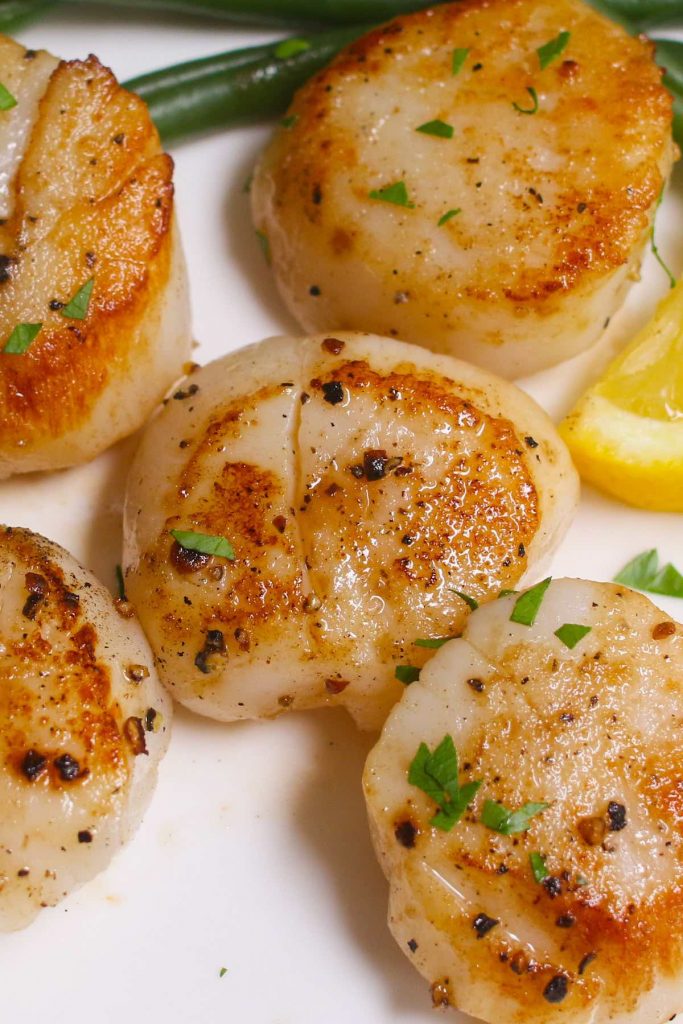
These tender scallops taste even better than the ones from a high-end restaurant. Serve this at a party, you’ll impress all your guests! They are evenly cooked to the precise temperature edge to edge, in a deliciously silky lemon butter glaze.
What is Sous Vide?
Sous vide means “under vacuum” in French. It’s known for being a precise and consistent way to cook your food evenly. Just vacuum seal your food in a bag, and cook them in a water bath to a very precise temperature. No more overcooked scallops!
Why Sous Vide Scallops?
Cooking scallops sometimes can be intimidating as they are very easy to overcook. As scallops are quite expensive, you don’t want to spend so much money and end up with rubbery and chewy scallops.
With the sous vide method, you’ll never undercook or overcook your scallops, and have the guaranteed result every time! You can use the same technique to cook shrimp too!
Equipment For Sous Vide Scallops
- Immersion circulator
- Vacuum-sealer (and bags) or a reliable zip-top bag
- A sous vide container or a large pot
- Skillet
- Kitchen tongs
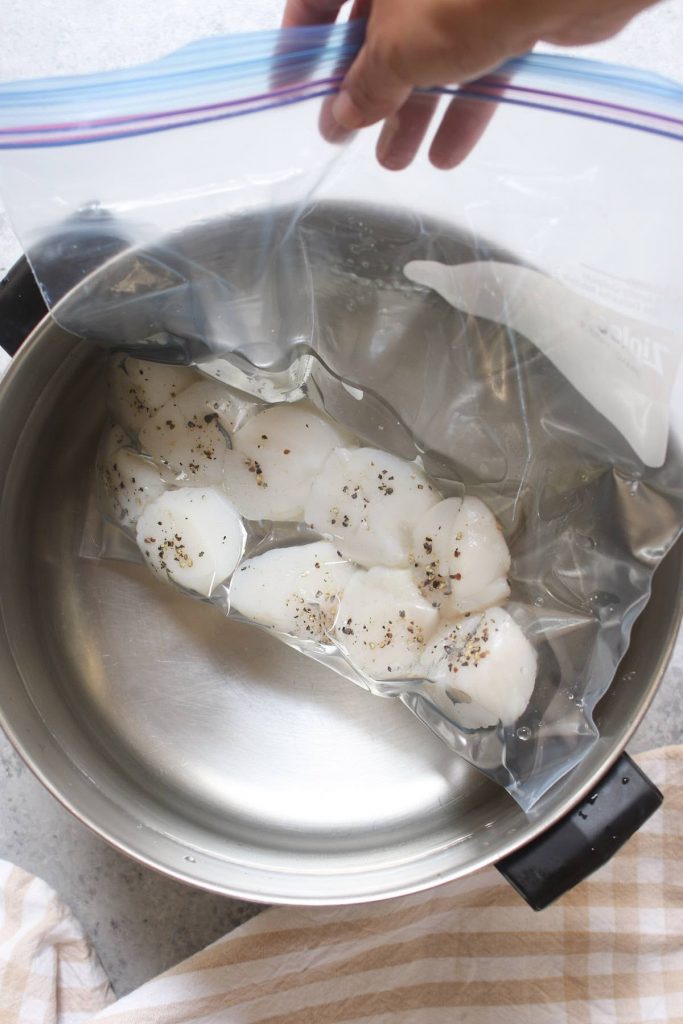
Ingredients You’ll Need
- Scallops: Try to find scallops that appear slightly pink or beige. If the roe (the bright orange and crescent-shaped part) is still attached, remove it as it’s a little bitter.
- Olive Oil: Regular olive oil works best for this recipe. Avoid extra virgin olive oil as it has a lower smoke point.
- Salt & Pepper: You can use regular table salt or coarse salt. Freshly ground black pepper works best.
- Butter: It helps the scallops to brown better while adding great flavors. I used unsalted butter in this recipe.
- Garlic: You can use either freshly minced garlic or garlic powder.
- Lemon Juice: It adds a sweet-tempering tang and delicious complexity of flavor.
How To Make Sous Vide Scallops With Step-By-Step Photos
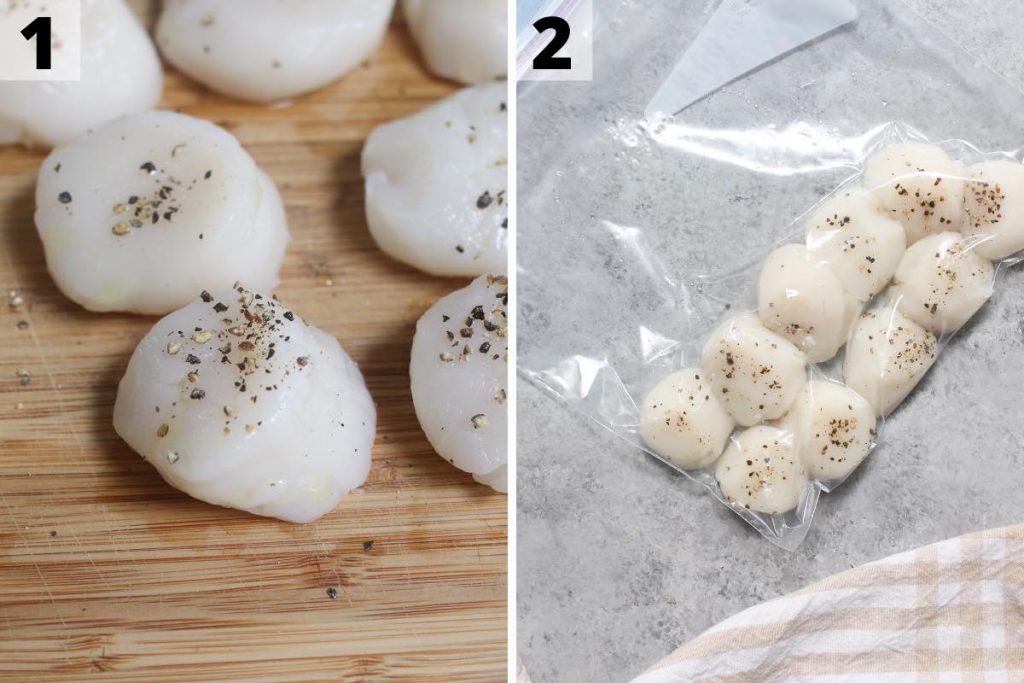
1. Season the scallops with salt, pepper, and olive oil.
2. Place the seasoned scallops in a large zip-loc bag and vacuum seal the bag using the “water displacement” technique.
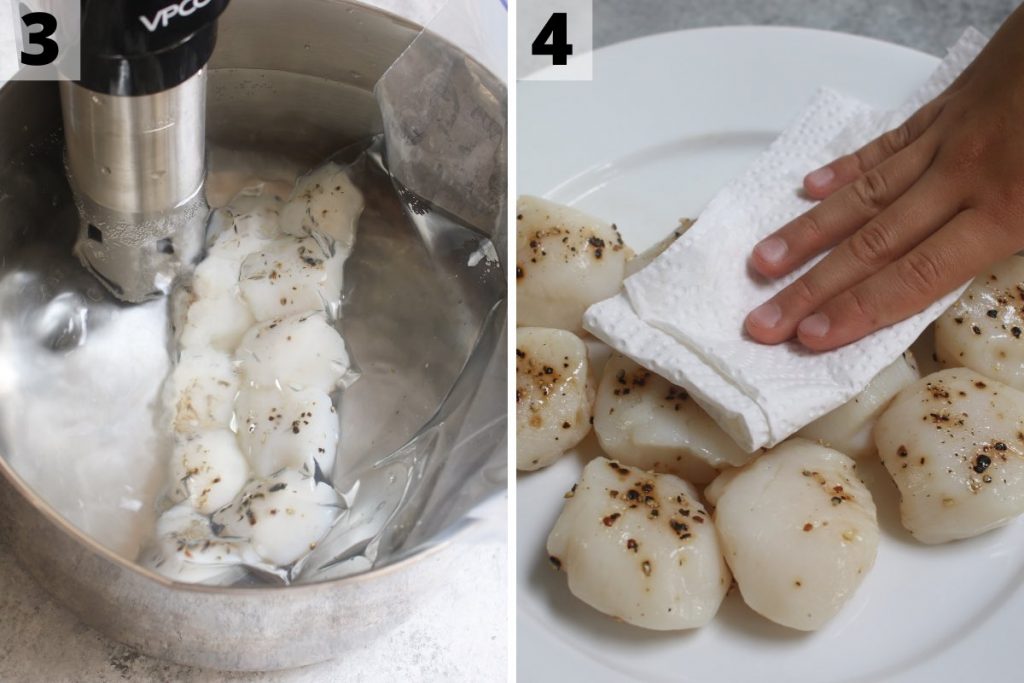
3. Place the bag in the water, and leave it in the water bath for 30 minutes. Make sure to submerge the scallops completely in the water.
4. Let it chill, and pat dry the surface with paper towels.
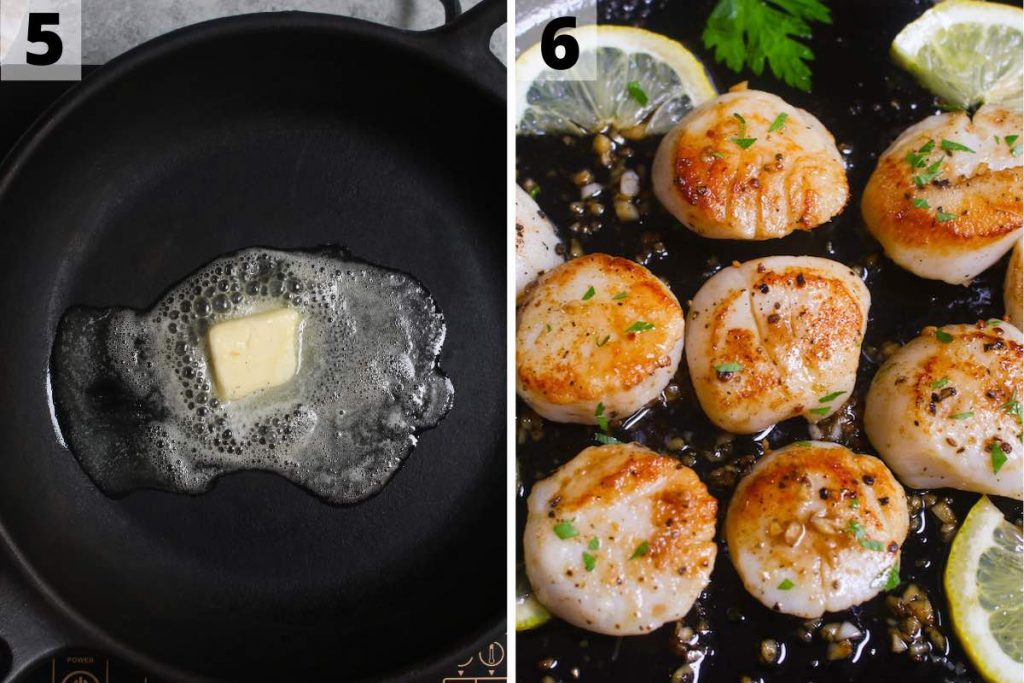
5. In a large skillet over medium-high heat, add the remaining 1 tablespoon olive oil and 1 tablespoon butter. Once the butter is melted, pan sear the scallops until caramelized on the surface.
6. Make lemon butter sauce. Toss cooked scallops with the sauce.
Tips & Tricks
- Single layer is important: It’s very important to keep the scallops in a single layer in the bag. If your bag is not big enough to hold it all in one layer, you can use multiple bags.
- You can use ziplock bags to vacuum seal the bag: Just place the scallops in a ziplock bag and seal all but one corner of the bag. Slowly place it into the water bath, and make sure everything below the zip-line is covered by water. Then seal the rest of the bag.
- Use an ice bath for better searing: If you cook your scallops immediately after they come out of the warm water bath, any rise in temperature will overcook them. Chill the scallops with an ice bath (about 10-15 minutes), you can cool the outside and a thin gradient of the interior, allowing a proper sear without endangering the sous vide doneness. Alternatively, you can chill your scallops in the refrigerator for about 1 hour.
- Don’t forget to pat dry before searing: In order to get proper searing, a dry surface on the scallops is the key! All you have to do is to pat dry your chilled scallops with paper towels, removing as much moisture as possible. This improves the contact between the skillet and the scallops, creating less steam during cooking.
Temperature and Time
Scallops are a lean protein source and the texture is best at medium-rare to medium doneness, so target 123°F (51°C) to 130°F (54°C). Within this range, the flesh is milky white and firm.
Overcooked or well-done scallops will be dry and rubbery. Personally, I like cooking it at 130°F because it’s closer to the traditional texture, but if you like the melt-in-you-mouth super tender (and slightly soft) texture, go for 123°F.
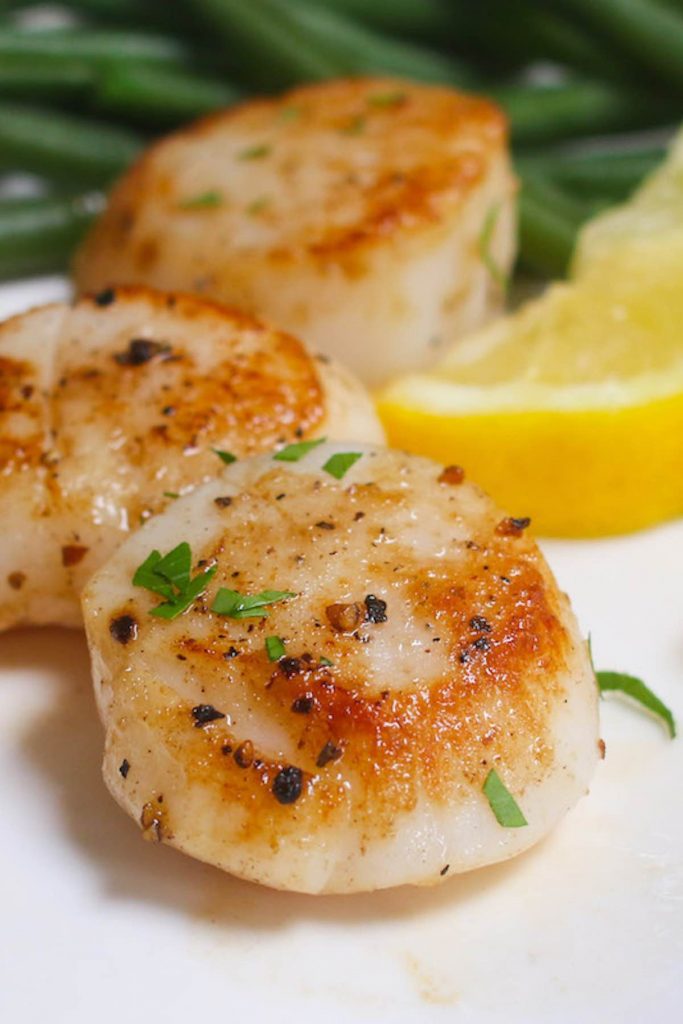
Best Way To Sear Scallops After Sous Vide Without Overcooking
I recommend transferring the bag of scallops to an ice bath after sous vide cooking. Let them chill for 15 minutes. You can also chill them in the refrigerator for about 1 hour.
When the scallops are chilled, remove them from the bag. Pat dry with paper towels COMPTETLY, as the moisture will prevent them from searing properly.
Heat the pan with oil and butter. In the meantime, season the scallops. Sear for a brief 30 seconds on each side until they develop a golden crust.
What To Serve With Sous Vide Scallops
Best Sauces For Scallops
In addition to lemon butter, here are my favorite sauces to serve with scallops:
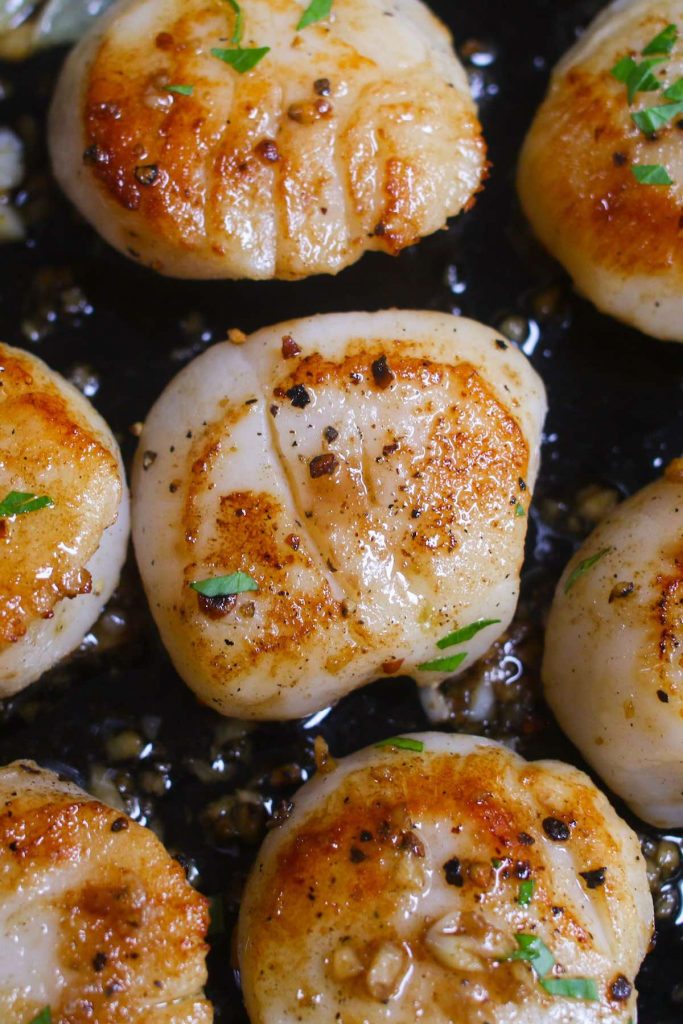
FAQs
Can I sous vide frozen scallops?
Yes. Sous vide method works well with frozen scallops too, and it’s super convenient.
To sous vide frozen scallops, follow the same instructions as cooking the fresh scallops, and add an extra 15 minutes of cooking time.
How to store leftover scallops
Let them cool to room temperature and store them in an airtight container. They’ll last 2-3 days in the fridge.
How to reheat scallops with sous vide
Set your sous vide water bath to around 123°F (51°C), and immerse the sealed scallops. Cook for 15-30 minutes until they’re heated through.
How long to sous vide baby scallops
The cooking time for baby scallops varies depending on their size. For small bay scallops (less than 1 inch in diameter), sous vide them for about 15-20 minutes.
Larger scallops will take a slightly longer time to cook. Check after 20 to 25 minutes, and add more time if needed.
More Sous Vide Seafood Recipes
I hope you like this recipe, and if you tried it, let me know how your Sous Vide Scallops turn out in the comments below!
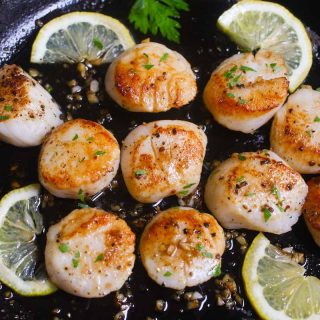
Sous Vide Scallops with Lemon Butter Recipe
Ingredients
- 1 pound scallops, 10-12 large sea scallops (454 grams)
- 2 tablespoons olive oil, divided
- salt and fresh ground black pepper to taste, (I used 1/2 teaspoon for each)
- 2 tablespoons unsalted butter, divided
- 3 cloves garlic , minced (or 1 tablespoon minced garlic)
- 2 tablespoons lemon juice
- 1 tablespoon chopped parsley, optional for serving
Instructions
- Fill a medium-sized container or pot with water, attach the sous vide precision cooker and set the temperature to 123ºF/51ºC. (Or 130°F/54ºC for a firmer texture).
- Remove the tough muscle from the side of the scallops if attached.
- Lightly season the scallops with salt, pepper, and 1 tablespoon olive oil.
- Place scallops in one single layer in a large resealable bag or vacuum seal bag. (Make sure to arrange in one layer. If your bag is not large enough, use multiple bags).
- Seal the bag using the “water displacement” technique or a vacuum sealer.
- Once the temperature has reached the target temperature, place the sealed bag in the water bath and set the timer for 30 minutes. Make sure to submerge the scallops completely in the water.
- When the time goes off, transfer the bag to an ice bath. Leave for 15 minutes (or you can chill them in the refrigerator for about 1 hour).
- When the scallops are chilled, remove from the bag and pat very dry with paper towels (wet scallops won’t sear properly).
- In a large skillet over medium-high heat, add the remaining 1 tablespoon olive oil and 1 tablespoon butter.
- When butter stops foaming, add scallops and fry for 30 seconds on one side (until a golden crust forms underneath), then flip and fry again for another 30 seconds until lightly browned. Remove from skillet and transfer to a plate.
- Add the remaining 1 tablespoon butter and garlic in the same skillet. Cook for about 1 minute until fragrant.
- Add in lemon juice and scrapping up any browned bits. Simmer the sauce for about 2 minutes.
- Remove the skillet from the heat and add cooked scallop back into the pan and toss with the sauce.
- Garnish with parsley if desired.
Notes
- If you use frozen scallops, follow the same instructions as cooking the fresh scallops, and add extra 15 minutes of cooking time in the sous vide cooker.
- Set the temperature to 130°F/54ºC for a firmer texture that’s still very tender.
Nutrition
Nutrition information provided is an estimate only and will vary based on ingredient brands and cooking methods used.
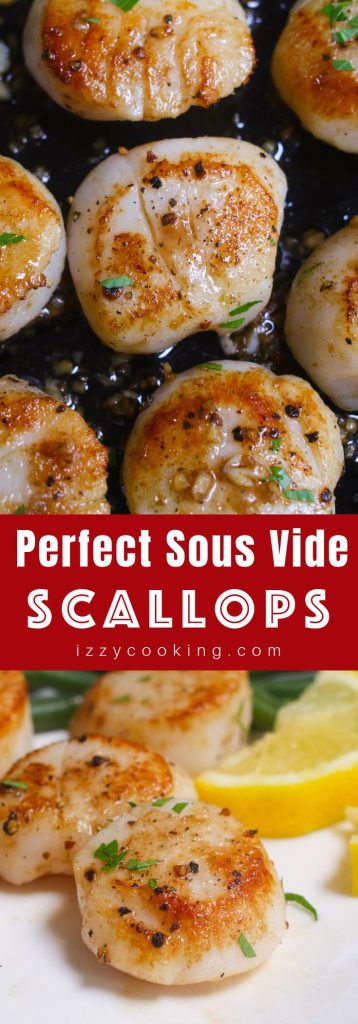
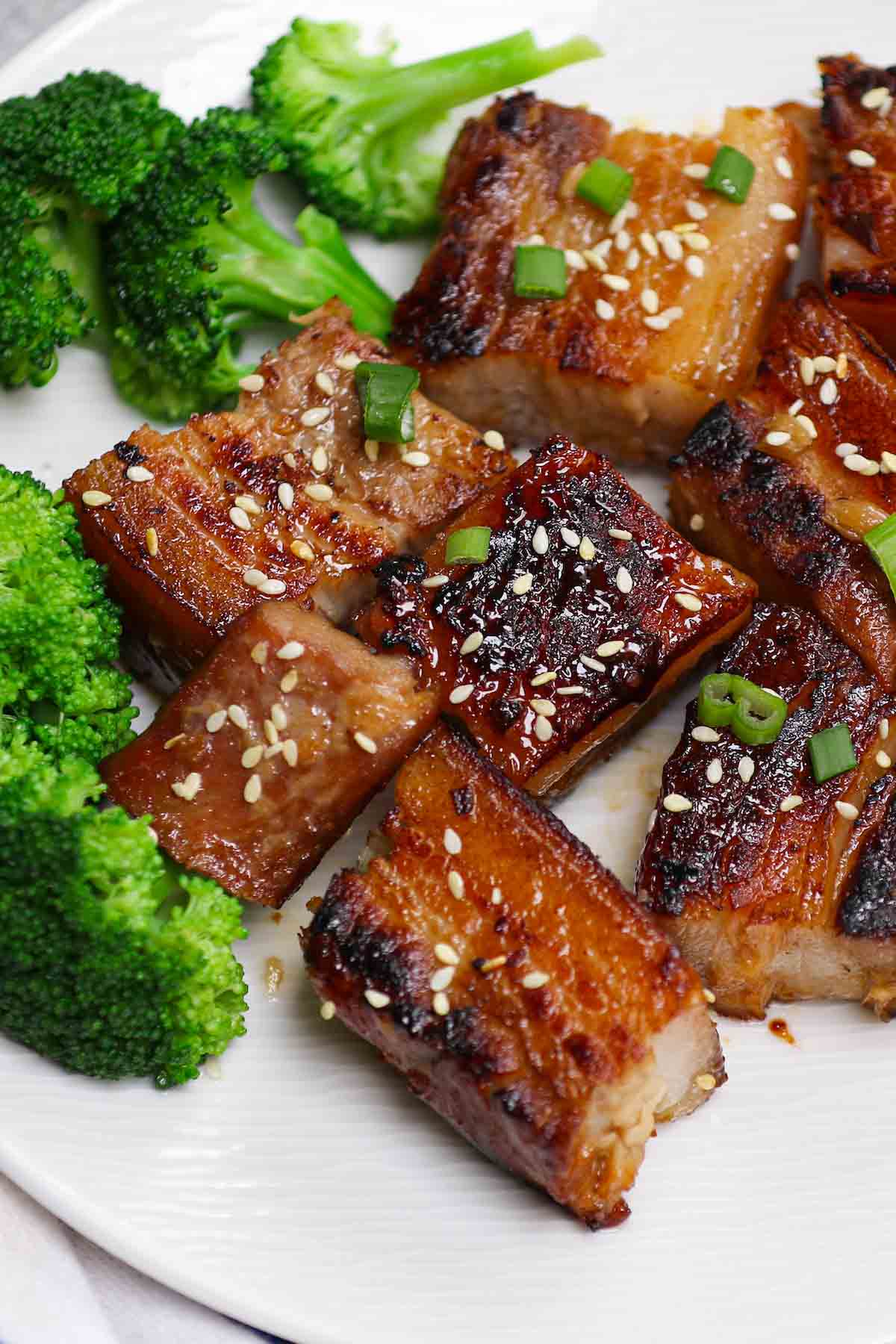
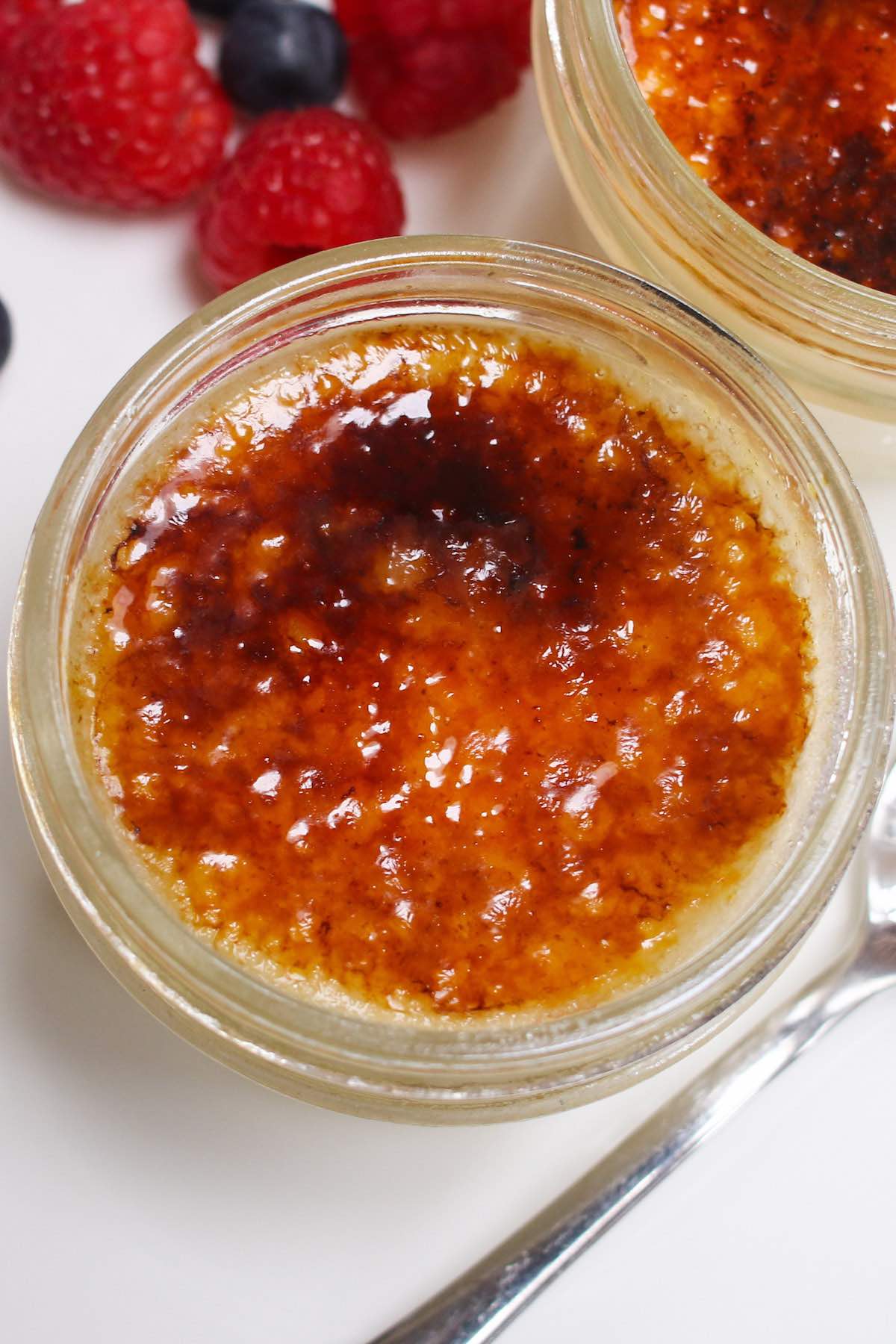
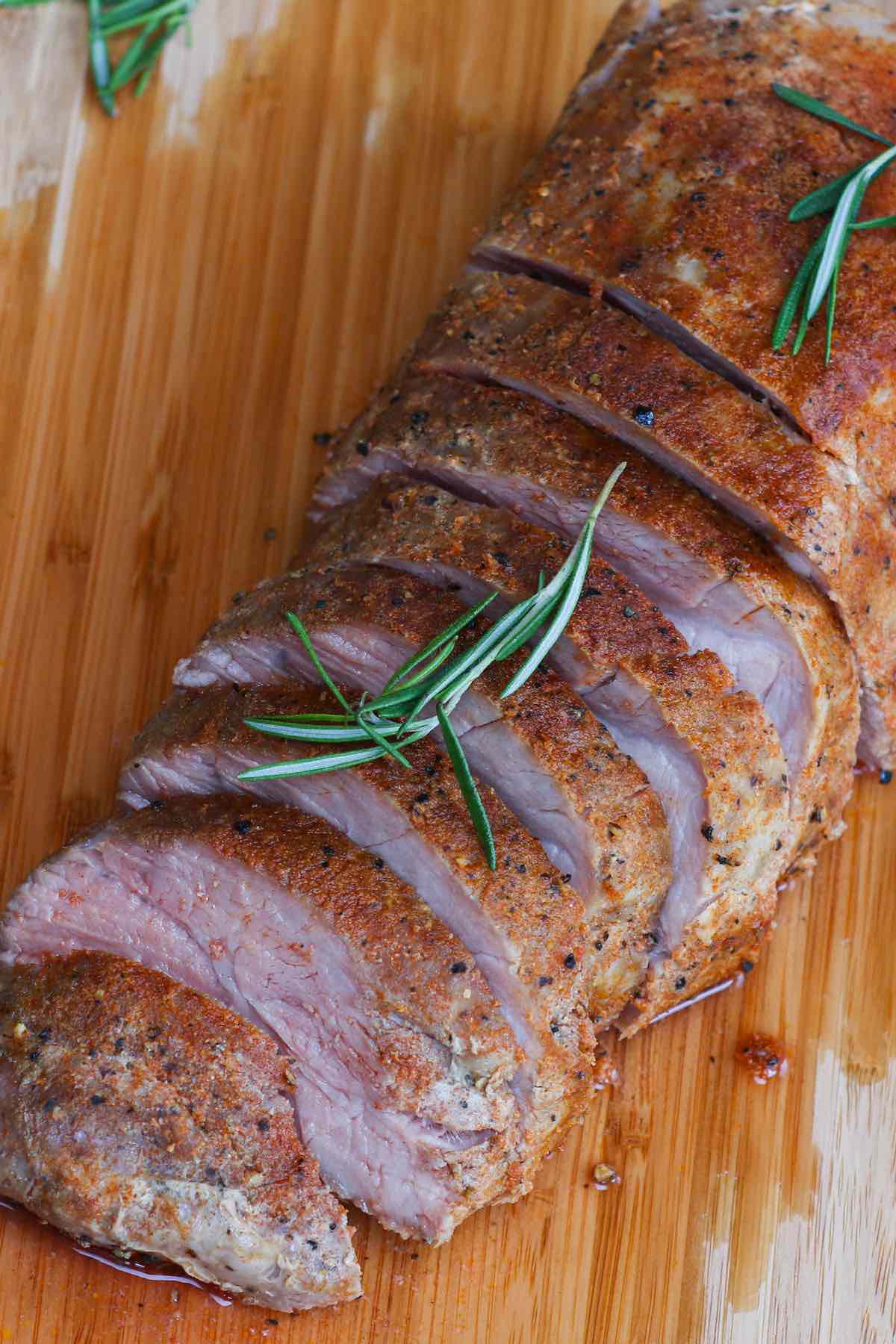
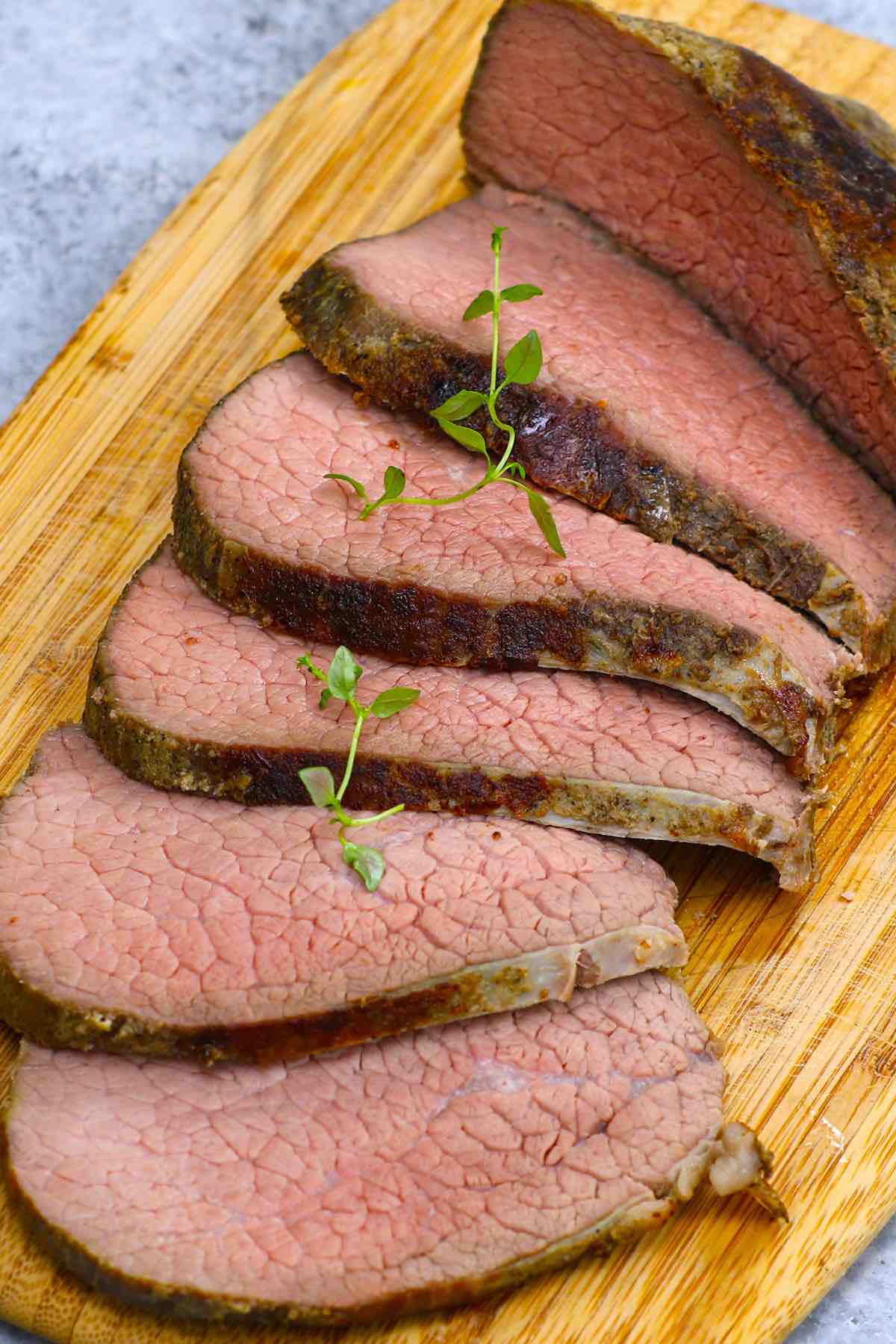
Scallops with lemon and butter sauce sound AMAZING! This makes me want to buy a sous vide cooker immediately! They are clearly cooked to perfection!
Thanks Kelly!
If I could eat scallops every day I would! love them and these look fabulous!
I don’t cook scallops-that is my husbands thing. He was looking for something new and this fit the bill. He had said this was very easy to make. Loved that he did not have to stand over the stove. He said the ice bath was crucial and ingenious. We tripled the sauce to serve over angel hair pasta!
Hi Kimberly, great to hear that. Thanks for letting me know! Izzy
Are you placing the scallops in the ice bath in or out of the plastic bag? Thanks
Last night we made scallops for the first time using our sous vide and this recipe; they turned out great! Izzy, your detailed instruction and suggestions are excellent and much appreciated. We are fairly new to using sous vide cooking and finding a trusted site is important. My husband is our sous vide chef and we are looking forward to trying more of your recipes. Thank you!
Hi Michele and Stephen, thanks for you letting me know. I’m so glad that you like the recipe. I love sous vide cooking and you can easily achieve the restaurant-quality meal at home! Izzy
I made this recipe this weekend, and we absolutely loved how they turned out. Perfect texture throughout all of them. Can’t wait to have them again.
Hi Bobbie, I’m so glad to hear that your scallops turned out perfect. Thanks for letting me know.
This recipe is a keeper. First time using the sous vide for scallops. They came out perfect.
I’ll be doing it this way from now on. I’ll be doing your honey garlic shrimp next.
Hi David, glad you like the recipe. Let me know how your honey garlic shrimp turns out! Izzy
The inside was a perfect texture. The lemon garlic sauce tasted great.
These were not as crisp as my usual recipe. Next time I’ll probably cover them in egg before crisping them up.
Hi Randy, glad that you like the recipe. I’d like to hear more about your tip of using eggs to make it more crispy. Thanks
Hi! Can I do these using the sous vide option in an InstaPot?
15 minutes in an ice bath? 15 seconds maybe.